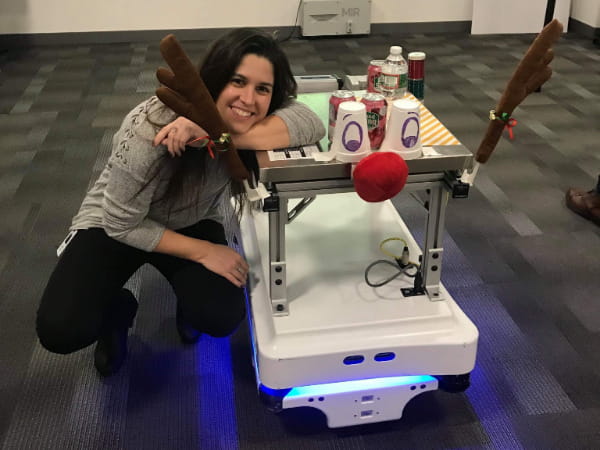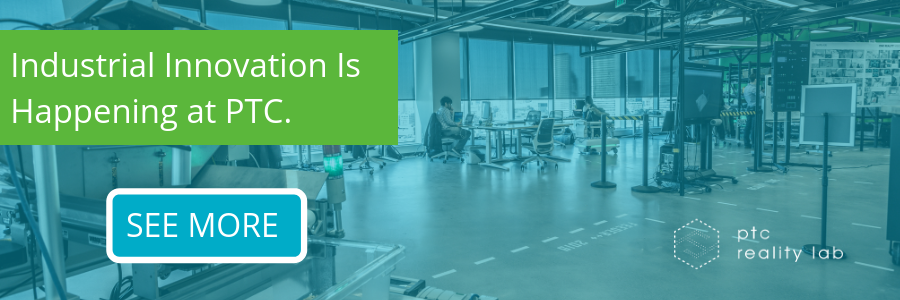Meet Frida – PTC Reality Lab’s MiR 100 Robot
The PTC Reality Lab doesn’t have a mascot, per se.
But it does have Frida – and for a mobile industrial robot, she has quite the fun personality.
At a company social around the holidays, Frida donned reindeer ears and, on Family Day, she delighted grandmothers and 6-year-olds alike.
For the team that works on PTC’s most innovative research projects and aims to solve complex industrial challenges, the MiR-100 AGV (Automated Guided Vehicle) just may be the perfect mascot.

More importantly, though, she’s a critical component to Senior Innovation Engineer Anna Fuste’s ongoing research: Kinetic AR, which explores the programming of motion in physical space. Working with Frida, Fuste has been building a prototype of a system that allows operators to use augmented reality to remotely control the robot, defining its motion in space and programming its movements.
“The vision behind everything we’re working on is to lower the barrier of entry to very complex systems,” Fuste explains. “It’s not a simple job to program a robot, we are working to design and develop the tools to make interacting with these systems easy and fast.”
Frida in Action
Take a look at this video where Fuste maps out a path in space for Frida to follow with a smartphone app:
This is an early (and simple) demonstration of the technology’s possibilities. The AGV has its own spatial mapping that Fuste synchronizes with the augmented reality spatial tracking. These allows the control of the robot in real-time using AR technology. The prototype can also be used to design other motions and actions for the robot to do, such as following the user’s position in real-time.
By integrating Fuste’s work with Reality Editor and the Reality Zone, the goal is for robots to navigate a dynamic factory floor safely and accomplish myriad tasks within a defined space. Using programming nodes in Reality Editor, users can link machines and AGVs. For example, by linking the robot to a feeder machine, the user can program the system so that the robot follows a path, waits until the feeder has filled the container and leaves to perform the next task.
“We want to enable more collaboration between humans, systems, and robots,” Fuste says.
There is a growing trend in industrial enterprises for collaboration between humans and machines, sometimes called “cobots”. Cobots are robots that are able to work alongside humans, often doing the tedious, repetitive work, or manual labor, which frees the worker to focus on more complex tasks and thinking.
Paramount to this type of collaboration is safety. With AR technology, safe areas can be defined and visualized directly in space – for both humans and robots to be aware of.
“AR shortens the learning curve to interact with complex machines.” Fuste says. “With the proliferation of machine learning and artificial intelligence, AR becomes a convenient technology to visualize AI intent, interact with smart agents, and make the collaboration between humans and machines more intuitive and efficient.”
The Creative Side of Technology
Creativity is an essential piece to the Reality Lab’s work. Creative problem solving is used to express their research goals uniquely, design systems that help them to iterate and drive them towards expressive solutions.
For Fuste, a self-described creative technologist, design and user experience (UX) are two areas of expertise that flow into everything she creates. She grew up in Barcelona, Spain, where she earned degrees in multimedia engineering and audiovisual communications, a combination that gives her the skills to express ideas effectively.
Since then, she’s been keenly interested in leveraging technology to create unique experiences, whether they’re artistic, educational, playful, or task-oriented. Connecting physical and digital spaces through augmented reality has been a core tenet for much of her research work.
After completing her undergraduate work, she lived in London and helped create interactive art exhibits with artist Dominic Harris and Cinimod Studios. The artworks she developed acted as ubiquitous windows to other digital spaces, such as a jungle, a butterfly wall or the tale of Snow White and the Seven Dwarfs.
The design and UX skills that she developed became extremely useful for her HCI research at MIT Media Lab. She created ARTextiles, where augmented reality was projected onto clothing to bridge the gap between our online selves from social media and our face-to-face interactions. She also created HyperCubes, a project to help children understand computational concepts in augmented reality.
During a 3-month stint at the Google Creative Lab, she helped develop the AR Experiments platform and created projects such as Draw & Dance, Paper Cubes and Invisible Highway.
Each of her experiences has built upon the last and helped her weave a dedicated process for creative thinking and development.
“All of us at the Reality Lab are very used to prototyping, developing, and iterating. Failure is not time lost. If we develop something and it doesn’t feel quite right, we never discard it,” Fuste says. “It may be useful for another project and we will have learnt a lesson.”
Working on industrial challenges is relatively new to Fuste, so it’s been incredibly valuable for her and the team to have their home in the Customer Experience Center (CXC) at the Boston headquarters. They regularly give demonstrations to customers and visitors – many of whom face the challenges their research is looking to solve. “They’re the real experts; with every conversation we learn more and gain a better understanding of what they need.”
--
Look for updates and insights on PTC’s Reality Lab here on the blog, including interviews, research, and discussion. Keep tabs on their exciting work by following the team on Twitter, @PTCRealityLab, and follow Anna Fuste, @afuste.
